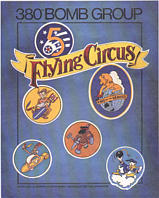 |
380th Bomb
Group Association
|
| JAPANESE ANTI-AIRCRAFT ARTILLERY AND FIGHTER UNITS IN THE SOUTHWEST PACIFIC |
INTRODUCTION
The 380th was opposed by the Japanese when we were on our combat missions by anti-aircraft artillery at every target of any value and by aircraft at all major Japanese airbases.
Those crews listed in Table 1 are those which were lost by the 380th to Japanese anti-aircraft artillery fire. Many others, too numerous to mention here, were damaged (from light to a heavier degree) but were able to return safely to our bases.
A much less frequent but more dramatic opposition was that with Japanese fighters of both the Japanese Navy and the Japanese Army Air Forces. Japanese Naval aircraft attacks occurred at Balikpapan, Borneo; Ambon and Halong, Ceram; at Koepang, Timor; Kendari and Macassar, Celebes; Taberfane in the Kai Islands; and Sorong, Vogelkopf, New Guinea, in the East Indies. They also took place at Rabaul and Gasmata on New Britain, when we were at New Guinea on detachment duty.
Japanese Army Air Force attacks took place at Ambon, Ceram; Koepang and Lautem, Timor; Taberfane in the Kai Islands, at Babo, Western New Guinea, and at Wewak and Madang in Eastern New Guinea.
According to available information, our contacts with Japanese Naval Air Force ZEKES were with the 202nd Kokutai, which had units at all the locations listed. Our most common contact with Japanese Army Air Force units was with the 5th Sentai's NICK twin-engine fighters. They had bases throughout the Southeast part of the Dutch East Indies at Lautem, Timor (the main base); Ambon, Ceram; Langgoer, Kai Islands; Sorong, Vogelkopf, New Guinea; and Babo, New Guinea. See Table 2. A Kokutai is equivalent to an American Group.
OSCARs were flown by the 63rd and 68th Hiko Sentais (equivalent to the Navy's Kokutai) of the Japanese Army Air Forces. The Japanese Army units tended to occupy the larger islands such as New Guinea, The Philippines, Halmaheras, etc., while the Navy occupied the smaller islands such as Java, the East Indies, etc.
Code names of the Japanese fighters are shown in Table 3.
In contrast to the U.S. practice of keeping the whole complement of an Air Force Group consolidated at one location, such as Darwin, Australia, for the 380th, the Japanese practice was to split up a group into squadrons or even flights and distribute them over a vast area such as from Java to the Vogelkopf of New Guinea for the 5th Sentai of the Army or the 202nd Kokutai of the Japanese Naval Air Force.
It is noted that all major Japanese aircraft contact occurred only in the early part of the 380th's assignment to the Southwest Pacific, i.e., prior to assignment to The Philippines and mainly prior to June 1944 - no losses to enemy aircraft attacks took place after May 1944.
present the Japanese fighter units in the East Indies and New Guinea areas during this time. Those checked are the ones most likely to have engaged missions of the 380th Bomb Group.References:
1. The Best in the Southwest - The 380th Bomb Group in World War II, by Glenn R. Horton, Jr., Library of Congress Card Number 95-079703, ISBN 0-9645959-0-7. Mosie Publications, Savage, MN, 1995, 513 pp.
2. Japanese Army Fighters, Part 1, ISBN 0-356-08224-5, MacDonald and James, London, 1976, 58 pp.
3. Mission Orders and Intelligence Reports, 380th Bomb Group. Library of Congress and National Archives of United States for period 1943-1945.
Click here for the PDF version
WE WENT TO WAR - Series Description